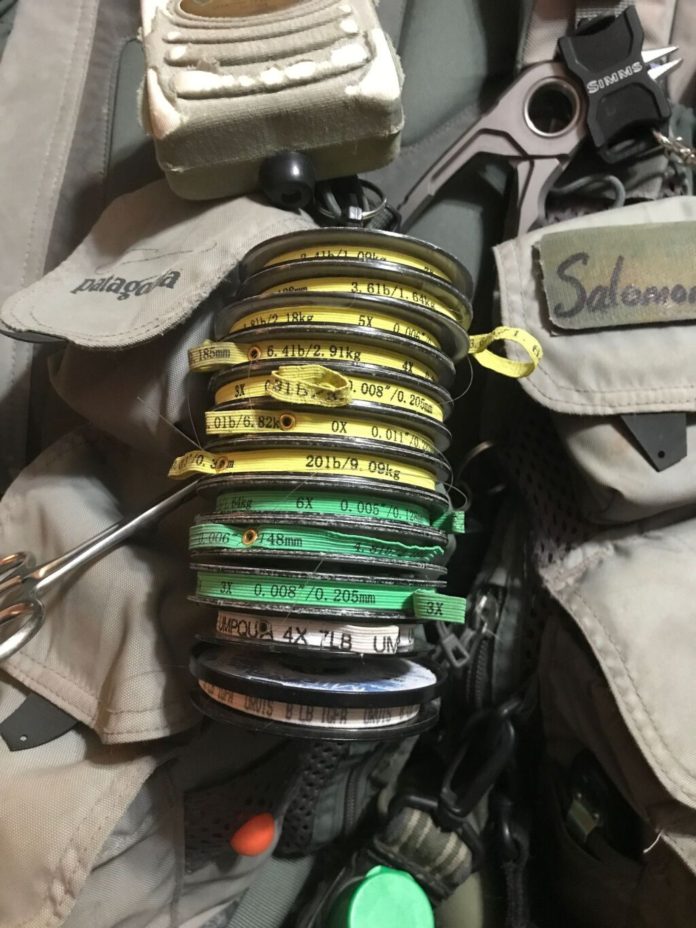Michael Salomone/Courtesy photo
It happened again the other day on the river, another angler commented on the rack of tippet that’s attached to my pack-vest. I didn’t even look down. What he was really telling me, was that he can’t tie knots. He doesn’t understand tippet. And he couldn’t construct a functional leader on the water if he had to. Whatever the reason, tippet is a common weak point in an angler’s rig. Taking a little time to decipher the critical component that tippet plays in the terminal equation will answer common questions, present useful tactics and explain why anglers carry an array of tippet.
Fly fishing tippet comes in a huge variety of sizes and weights categories. Size means diameter of the material. Tippet is more accurately measured and used when anglers have an understanding of this characteristic. However in this day and age anglers are better versed in “X.” And they purchase leaders and tippet material accordingly.
Michael Salomone/Courtesy photo
Tippet comes in two varieties of material, nylon monofilament and fluorocarbon. Gaining a basic understanding of these two materials is very straightforward. Understanding the why of when to use one or the other is a key component to successful angling.
Nylon monofilament is a softer material. Mono, as it is commonly referred to, stretches slightly. And mono is easier to tie knots. As a tippet material, mono will float and hold up on the surface making monofilament the tippet material to use when dry fly fishing. Monofilament is cheap to produce and that cost translates down to the cash register, saving anglers a few dollars.
Michael Salomone/Courtesy photo
Fluorocarbon is a stiffer material. Fluoro, as it is commonly referred to, does not stretch. The material is difficult to seat a knot down properly or in haste. And fluorocarbon will sink. However, fluoro has a refractive index that makes it virtually disappear underwater. This trait alone makes fluoro the material to use when nymph fishing, in saltwater or highly abrasive conditions. But when it comes to the cash register anglers routinely pay exponentially higher prices for this tippet material. Expensive costs in the production of fluorocarbon require anglers to pay more in the end.
When it comes to knots for attaching your tippet material to your leader my favorite is a Double Uni knot or Uni to Uni knot. This knot is easy to understand and tie. And with a minimal amount of dexterity an angler can learn to tie this correctly. As with all knots, lubrication is key. Wet your line before cinching it uptight. In this day and age of COVID-19 I shy away from using my mouth. However I am fishing and either standing in or floating on the water, instant knot moisture.
The rack of tippet I carry on my pack-vest allows me to construct a functioning leader on the river if a terminal rigging fails or an unsalvageable bird’s nest occurs. The Uni to Uni knot allows me to create a proper, functioning leader in a custom length for difficult angling situations such as dry fly fishing on spring creeks. Long leaders in the 12-15 foot length are necessary to present the fly with a delicate touch and to disguise the angler from wary trout.
One thought on tippet that the difficult water conditions of the past few summers have illustrated, anglers should strive to get away with the heaviest weight of tippet possible. The reason being this, a trout caught on 6X tippet needs a gentle touch during the fight to prevent breakage, so the battle is inherently extended. Whereas the angler using 4X tippet material can work the fish with a little more emphasis, shortening the battle and ushering the trout into a net more quickly. During adverse water conditions, a heavier tippet is a more ethical choice.
Credit: Source link































